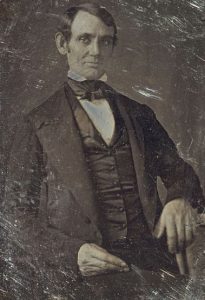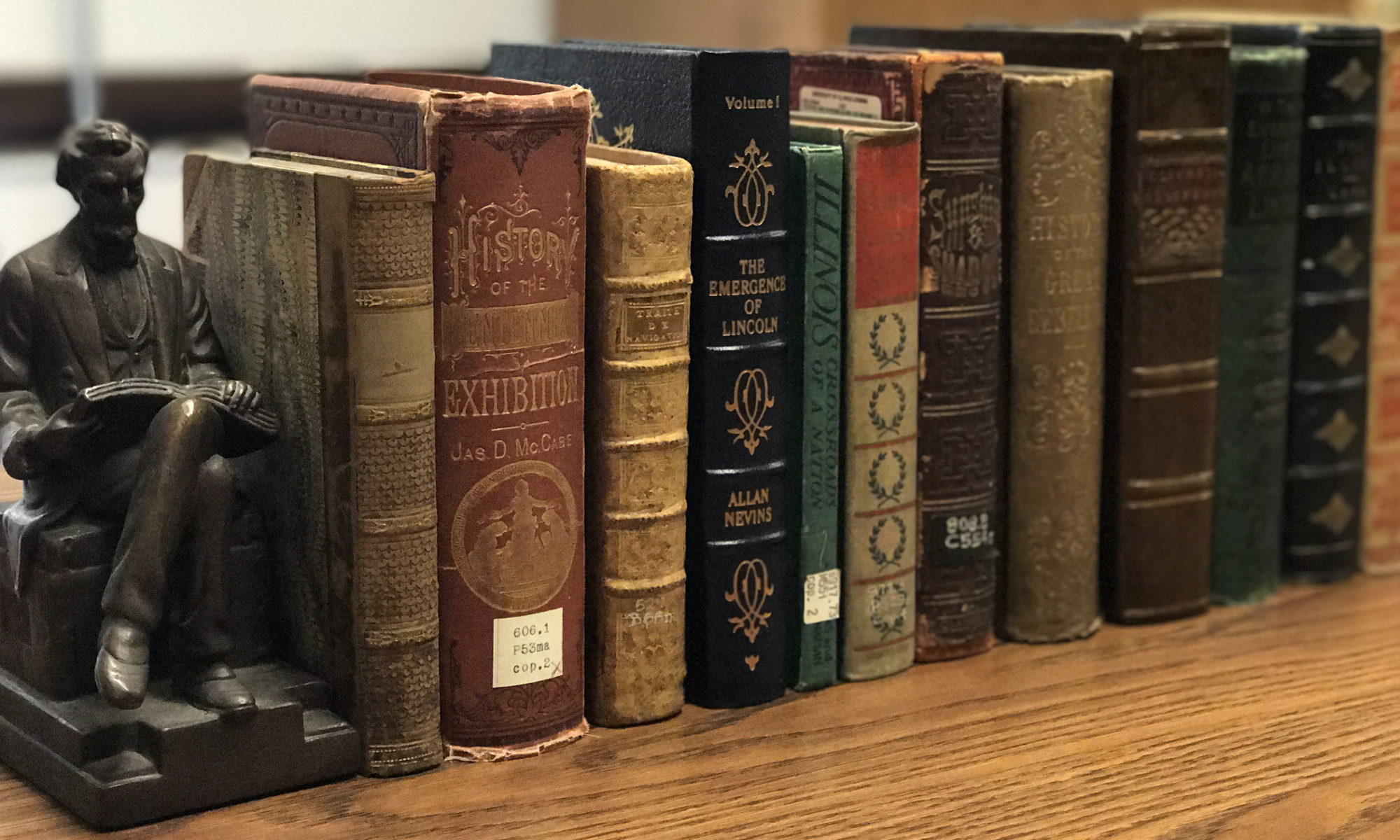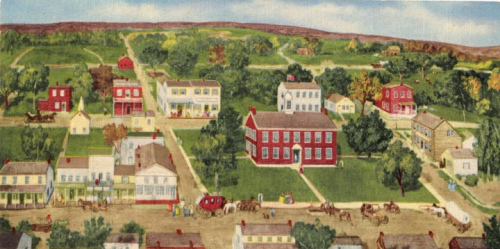This week we’re visiting Vandalia, Illinois (population 7,012) for #SmallTownSaturday!
The origins of this Fayette County town go back to May 1819. When the State of Illinois was formed and admitted to the Union less than a year prior in 1818, the historic village of Kaskaskia was chosen as its first capital. Within months though, the state was in search of a better location as Kaskaskia was under constant threat of flooding from the Mississippi River. Congress then donated land to the state for the purpose of founding a new capital, and in May 1819 five commissioners were sent to select the new site. They chose a wooded area known as Reeve’s Bluff ninety miles northeast on the western banks of the Kaskaskia River. By constitutional provision, this new spot was to be the state capital for the next twenty years. Thus Vandalia was born.
Founded specifically to be the new Illinois capital city, Vandalia was hastily built so as to be ready for the December 1820 session of the General Assembly. The key building in all the construction was, of course, the statehouse itself. Commissioned for $4,732, the final product was a plain two-story wood frame building. Illinois’s second capitol was, as one legislator described it, “primitive and plain as a Quaker meeting house.” It was also fairly small for a capitol building, providing no permanent space for the Illinois Supreme Court or the state’s executive offices. The State Treasurer, in fact, operated out of his own home while the Secretary of State worked out of an office in the nearby state bank.
While the town’s architecture may have initially been “ramshackle,” Vandalia could boast of a greater cultural and intellectual life than most places in the West. Vandalia’s status as state capital regularly brought well-educated and talented residents and visitors to the remote village. Writing of the “intellectual feasts” she enjoyed in town, one legislator’s wife recounted the stimulating lectures and political and legal debates available for public consumption. One visitor, James Stuart, recalled meetings of the local historical society and praised them as being “as regular, and as well conducted” as if “the society had been at Oxford or Cambridge.” An early immigrant to Vandalia, a wealthy German named Ferdinand Ernst, brought with him a colony of other German immigrants who introduced the music of Beethoven, Mozart, and Haydn to the town. Other people calling Vandalia home at this time included the painter James W. Berry and authors like James Hall.
Still, the state capital was not totally immune to the violence and other problems that plagued many frontier towns. In December 1823, a mere three years after its construction, the statehouse was burned down under suspicious circumstances connected to a campaign to outlaw slavery in Illinois. This, of course, necessitated a third state capitol building. Within two months, work had begun and local citizens contributed some $3,000 to the effort. The new statehouse stood two stories tall and, for the first time, incorporated office space for the Supreme Court, Secretary of State, and other officials. It was also in this building that a young Abraham Lincoln took his seat as a Representative for Sangamon County in 1834.
The capitol’s hasty construction on low, moist ground soon showed though. The walls cracked and bulged, the floor sank seven inches, and by 1836 it was decided that the building was too far gone for repairs. Vandalians again contributed labor and materials for a new $16,000 statehouse on the previously vacant public square. Measuring 150 feet by 50 feet, Illinois’s fourth capitol likely seemed statelier than its predecessors with its cupola and exterior brick. Unfortunately, it was also incomplete at the start of the December 1836 session with legislators enduring the smell of wet plaster as workers buzzed around them. On top of that, despite being the largest statehouse so far, it was too small to accommodate the enlarged General Assembly following the latest census. On January 24, 1837, with Vandalia’s twenty-year term as capital expiring in the near future, Orville Hickman Browning introduced a bill to select a new, permanent capital city. Lincoln and the rest of the Sangamon County delegation, known as the “Long Nine,” successfully agitated for a move to Springfield in 1839.

1848 daguerreotype
Although Vandalia at first declined in the years following the capital’s move to Springfield, the village was revitalized in 1855 with the completion of the Illinois Central Railroad. Today, Vandalia is home to a humble population of 7,042. While the third capitol building was razed and no photos are known to exist, Vandalia still preserves the fourth and oldest surviving Illinois statehouse as the Vandalia State House State Historic Site.
Want to learn more about the history of this small town? Come visit us at the Illinois History and Lincoln Collections! From books like Paul Stroble’s High on the Okaw’s Western Bank to manuscript collections like Thomas Mather letters and Dorothy Golden postcards, we have a wealth of resources available to anyone interested in historic Vandalia, Illinois.
IHLC Resources
Burtschi, Joseph Charles. Documentary History of Vandalia, Illinois: The Capital of Illinois from 1819 to 1839. 1954. Call Number: 977.3797 V28D.
Burtschi, Mary. Vandalia: Wilderness Capital of Lincoln’s Land. Vandalia, IL: The Little Brick House, 1972. Call Number: 977.3797 B95V.
Ford, Thomas. A History of Illinois from its Commencement as a State in 1818 to 1847. Chicago: The Lakeside Press, 1945. Call Number: 977.3 F751995.
Stroble, Paul E. High on the Okaw’s Western Bank: Vandalia, Illinois, 1819-1839. Urbana: University of Illinois Press, 1992. Call Number: 977.3797 ST87H.
—. “The Vandalia Statehouse and the Relocation to Springfield.” Illinois Heritage 2, nos. 3 and 4 (Spring-Summer 2000). Call Number: Q. 977.3005 ILH.
Other Resources
“Vandalia State House.” Illinois Department of Natural Resources Historic Preservation Division. Accessed November 14, 2018. https://www2.illinois.gov/dnrhistoric/Experience/Sites/Southwest/pages/vandalia-statehouse.aspx.


Thank you for your response. The information about Lincoln’s residence while in Vandalia was very interesting; a mystery.
I, like so many, consider Abraham Lincoln one of America’s greatest Presidents …it is surprising that such details are not known.
The search continues. Thank you.
Hello Steve,
Thank you for your comment. I found a few passages that may be of interest to you. The first one details Lincoln’s arrival to Vandalia in November, 1834:
“The towering Lincoln, dressed in the first expensive suit he had ever owned, claimed his bag, hastily surveyed the public buildings and the more numerous taverns on the square, then followed Stuart (note: John Todd Stuart of Springfield, IL) into one of the inns, registered, and took up residence as Stuart’s roommate, under the same roof with some thirty other temporary residents.”
This passage is from “Lincoln’s Vandalia: A Pioneer Portrait” (1949) by William E. Baringer, held within our collection, here. The book also mentions names of taverns that typically housed legislators: Vandalia Inn, National Hotel, Charter’s Tavern, Sign of the Green Tree, and the New White House. These were all on the square in Vandalia. It does not say which inn Lincoln stayed at.
The second passage is from “Vandalia: Wilderness Capital of Lincoln’s Land” (1963) by Mary Burtschi (in our catalog here). In this book, there’s a chapter called “The cottage believed to have been Lincoln’s lodging.” It says:
“History haunts a prim little cottage which stands west of the Baptist Church between Sixth and Seventh Streets. The white-painted dwelling whose address is 615 West Johnson reminds one of the Bryant House at Bement where Lincoln and Douglas are supposed to have made their agreement to debate. It has been reported since capital days that the humble dwelling sheltered Lincoln for one legislative session. He took his rest in the simple southwest room of the house that has stood as a landmark in Vandalia’s history.”
Burtschi attributes this oral account to Mrs. John Van Dortsen, a Vandalia resident. There is no information about when Lincoln may have stayed in this cottage.
I hope this helps a bit!
I am very curious to know the address or, at least, the general area where Abraham Lincoln lived while in Vandalia, Illinois. I have read accounts that suggest the place he lived no longer exists. I am surprised that even it’s location seems to be uncertain (…or possibly guarded.) Can you help?